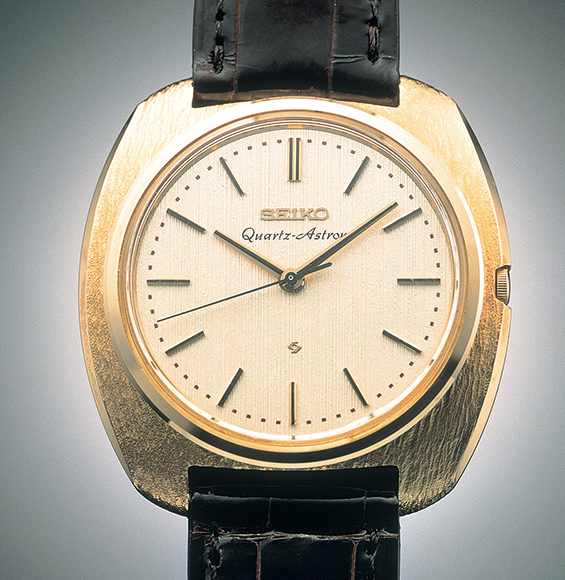The Seiko Museum
3.Revolutionizing Accuracy with Quartz Technology
While Seiko has innovated extensively in numerous aspects of timekeeping, it is arguably most passionate about quartz technology, to which numerous examples at the Seiko Museum attest. They include the inaugural Quartz Astron in its 18-carat gold case.

Quartz Astron in its 18-carat gold case
Quartz Technology Origins
The Quartz Astron transformed timekeeping when it debuted in December 1969 as the world's first quartz watch sold to the market. It was the fruit of intensive efforts from the late 1950s at Seiko to develop quartz technology, the inspiration for which originated with Pierre Curie observing piezoelectricity in quartz in 1880. Warren Marrison and J.W. Horton at Bell Telephone Laboratories drew on several subsequent advances to create the first quartz clock.
Ground-Breaking Miniaturization
Quartz clocks were far more accurate than mechanical timepieces but were incredibly bulky. Mr. Marrison's masterpiece filled a room. Seiko's first foray into quartz technology resulted in the Broadcast Clock. In 1958, Seiko set about developing a quartz marine chronometer, which weighed 30 kilograms. By 1963, the company had created the Crystal Chronometer, which weighed just 3 kilograms and was used at the Tokyo Olympics in 1964, the first deployment of a comprehensive electronic timing system at the Olympics.
The pivotal technologies that went into what became the Astron were a tuning fork-shaped crystal oscillator that contributed to stability and shock resistance, a hybrid IC unit, and a step motor that could run for a year without a battery change. These and other advances seem par for the course now, but back in the 1960s they were anything but easy to innovate, requiring the involvement of Seiko's best engineers and significant financial resources. But the effort was well worth it, and the resulting quartz, semiconductor, liquid crystal, and magnetic technologies eventually went into service in devices, printers, and audiovisual equipment that have served untold millions of people around the world, including from Seiko group companies.
Open to the World
There was one curious outcome from Seiko's quartz-based advances. Upon the Astron's debut, management decided to make the key technologies open. This decision was, and remains, a source of immense pride among Seiko's people today, not least Seiko Museum officials. Offering the technologies to the world made Seiko a pivotal standard maker in quartz movements, which are now by far the most popular for wristwatches.
Adding Value
Seiko priced its first Astron at around the price of a new car. Within a few years of the company giving away its technology, retail prices of quartz watches plummeted to just a few dozen dollars, damaging Seiko's market prestige.
There again, Seiko's corporate culture inherently loves a challenge, and its people were convinced that they could uphold the quality and reputation of quartz technology by employing it in the world's best watches.
One key example of that commitment is the Quartz Caliber 9F series in several current Grand Seiko watches. Value-added features include a twin pulse control motor, a backlash auto-adjust mechanism (which is why the second hand stops exactly, vibration-free, on the second marker), and an instant calendar change (just 1/2000th of a second). Another is the Seiko Astron GPS Solar. Fittingly, this was the world's very first GPS Solar watch and is a marvel to behold, with an accuracy of one second every 100,000 years. It is truly a value-added, revolutionary timepiece for the ages.

Grand Seiko 9F Quartz
Next Up…
In the next installment of this series about the Seiko Museum, we'll focus on traditional Japanese clocks.